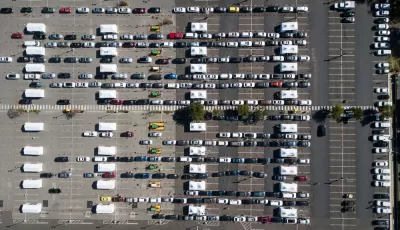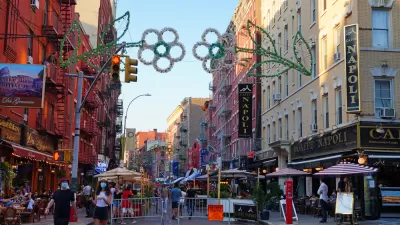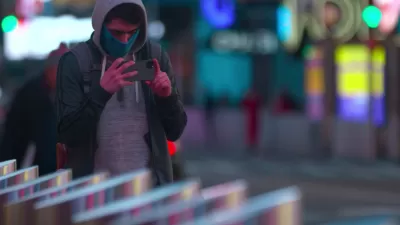Here are just a few ways urban environments are transforming and reinventing themselves in the wake of the coronavirus.

A year ago, the world was just beginning to understand COVID-19's devastating effects. Millions of people had already been infected and researchers had begun the long, arduous quest to develop a vaccine. Now, those long-awaited immunizations are finally here and the United States is rolling out more than two million vaccines each day.
With nearly half of Americans having received at least one dose, hope is on the horizon. The Centers for Disease Control and Prevention (CDC) even lifted the mask mandate for fully vaccinated individuals (although not without controversy).
As more people get their immunizations, the vaccine will continue to change cities across the United States. Businesses and consumers are bracing for a new post-pandemic normal.
Here are just a few ways urban environments are transforming and reinventing themselves in the wake of the coronavirus.
Immunity Passports
Thousands—if not millions—of scientists and researchers have been tirelessly working behind the scenes to find a vaccine. From studying autopsied lung tissues to conducting clinical trials, they successfully provided the world with vaccines in just ten short months. Now, those who have received a full dose can go practically anywhere without a mask.
Of course, this is wonderful news for struggling businesses in America's once-bustling cities. However, some establishments are requiring that customers provide proof of immunization before entering their establishments. Already, Italy, Germany, and the United States are floating ideas for country-wide immunity passports that would allow vaccinated individuals to travel freely.
Not everyone is on board with the idea, but these certificates will likely remain a possibility for the foreseeable future.
Contactless Interactions
Regardless of whether businesses currently require proof of immunity, most will likely adopt contactless technologies to minimize the spread of COVID-19 and other viruses. For instance, instead of touch-based interfaces, many companies will transition to voice-activated, contactless transactions.
For example, Vaylant AI is testing a new way of ordering food at quick-serve restaurants that involves customers using a voice-controlled kiosk to place orders.
Meanwhile, Amazon has recently opened its first cashier-less grocery store in London. It also runs a handful of autonomous Amazon Go stores to minimize contact.
Other contactless technologies, like Apple Pay and touch-free airport check-in kiosks, will become more popular as well. However, it may be some time before consumers enjoy widespread contactless interactions. After all, many companies were just beginning to adopt touch-pad technology. Now they must rapidly invest in and install touch-free devices to stay in business.
A New Era of Urban Design
Outside spaces become a safe haven for many people during the pandemic, including those living in some of America's largest cities. Now, architects, designers, and engineers are working together to rethink urban landscapes and make more room for green spaces. One solution could be to level empty shops or transform parking lots into small parks or gardens. Alternatively, architects continue to prioritize create living walls and green roofs.
Many businesses are also redesigning their layout to accommodate the increasing flow of customers. Parking lots and sidewalks are turning into outdoor dining spaces. And with fewer people commuting, some cities are turning entire blocks into pedestrian-friendly watering holes and shopping areas.
As more people return to the hustle and bustle of city life, more new approaches to urban design are inevitable.
Hybrid Work Setups
Where and when people work is also playing a key role in how cities are changing. Since vaccine rollouts began, some companies have begun to welcome employees back to the office. Now, 4.3 million Americans work from home at least half the time, making a hybrid work model increasingly popular.
Many cities will still look to attract professionals by creating co-working spaces. While they currently comprise less than 5% of the commercial real estate market, some industry experts expect them to account for 30% by 2030. These spaces may provide everything from coffee to childcare to cater to the' unique needs of employees.
Mass Emigration
Meanwhile, countless businesses—most notably large tech companies—have declared a permanent remote work setup. Their office buildings, which now sit empty, have become prime real estate for investors, who are turning them into residential living spaces. As more units become available and cities struggle to recover economically, rent prices will likely remain low for the next few months. Investors hope these apartments will attract young professionals yearning to experience life in the big city.
Still, there might be a mass exodus of city dwellers who simply can't afford the urban lifestyle anymore. This crowd may include small business owners who were forced to close up shop and individuals who lost their job during the pandemic.
Tech companies like Tesla and Oracle have also recently announced their exodus from the Bay Area to avoid paying expensive wages and pricey office rents.
The Future of Post-Vaccine Cities
Vaccines have finally given cities a small sliver of hope. However, their futures are still uncertain as many Americans emigrate to and from large urban areas.
Will Americans still feel too unsafe to return to the big city, or will more people flock to bustling environments in search of a fulfilling social life? Only time will tell, but the future is undoubtedly brighter than before.

Study: Maui’s Plan to Convert Vacation Rentals to Long-Term Housing Could Cause Nearly $1 Billion Economic Loss
The plan would reduce visitor accommodation by 25,% resulting in 1,900 jobs lost.

North Texas Transit Leaders Tout Benefits of TOD for Growing Region
At a summit focused on transit-oriented development, policymakers discussed how North Texas’ expanded light rail system can serve as a tool for economic growth.

Why Should We Subsidize Public Transportation?
Many public transit agencies face financial stress due to rising costs, declining fare revenue, and declining subsidies. Transit advocates must provide a strong business case for increasing public transit funding.

How to Make US Trains Faster
Changes to boarding platforms and a switch to electric trains could improve U.S. passenger rail service without the added cost of high-speed rail.

Columbia’s Revitalized ‘Loop’ Is a Hub for Local Entrepreneurs
A focus on small businesses is helping a commercial corridor in Columbia, Missouri thrive.

Invasive Insect Threatens Minnesota’s Ash Forests
The Emerald Ash Borer is a rapidly spreading invasive pest threatening Minnesota’s ash trees, and homeowners are encouraged to plant diverse replacement species, avoid moving ash firewood, and monitor for signs of infestation.
Urban Design for Planners 1: Software Tools
This six-course series explores essential urban design concepts using open source software and equips planners with the tools they need to participate fully in the urban design process.
Planning for Universal Design
Learn the tools for implementing Universal Design in planning regulations.
City of Santa Clarita
Ascent Environmental
Institute for Housing and Urban Development Studies (IHS)
City of Grandview
Harvard GSD Executive Education
Toledo-Lucas County Plan Commissions
Salt Lake City
NYU Wagner Graduate School of Public Service






























